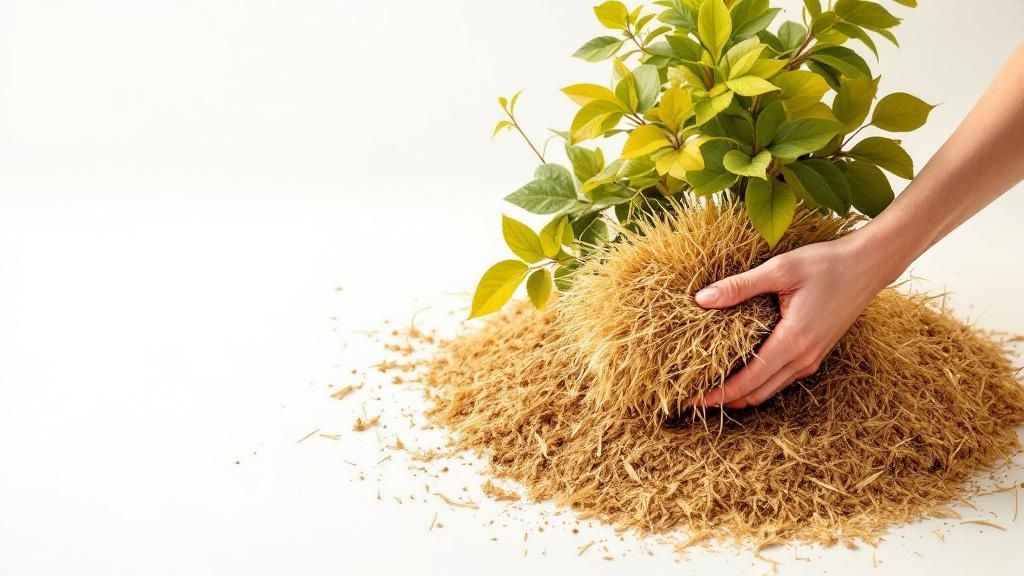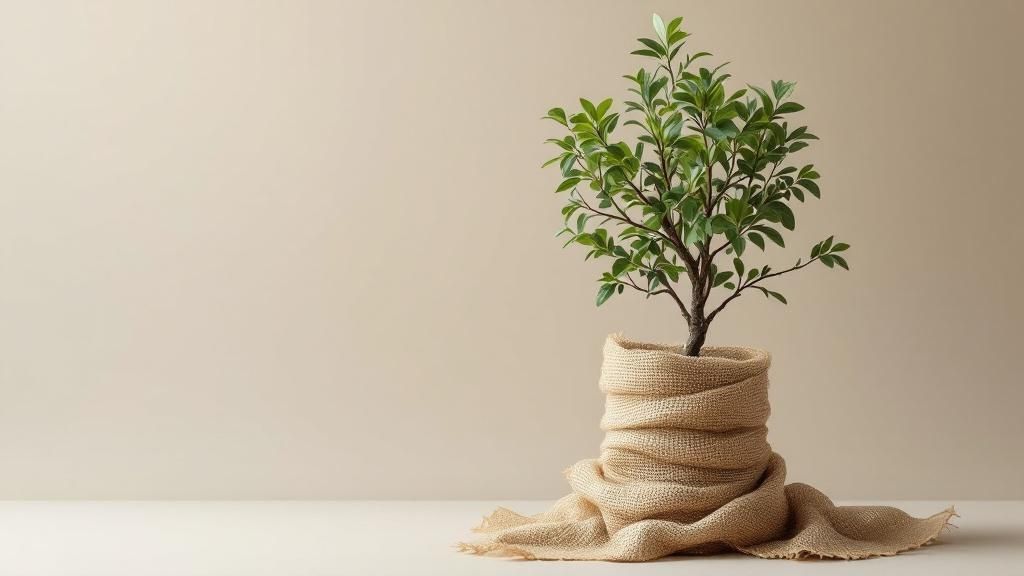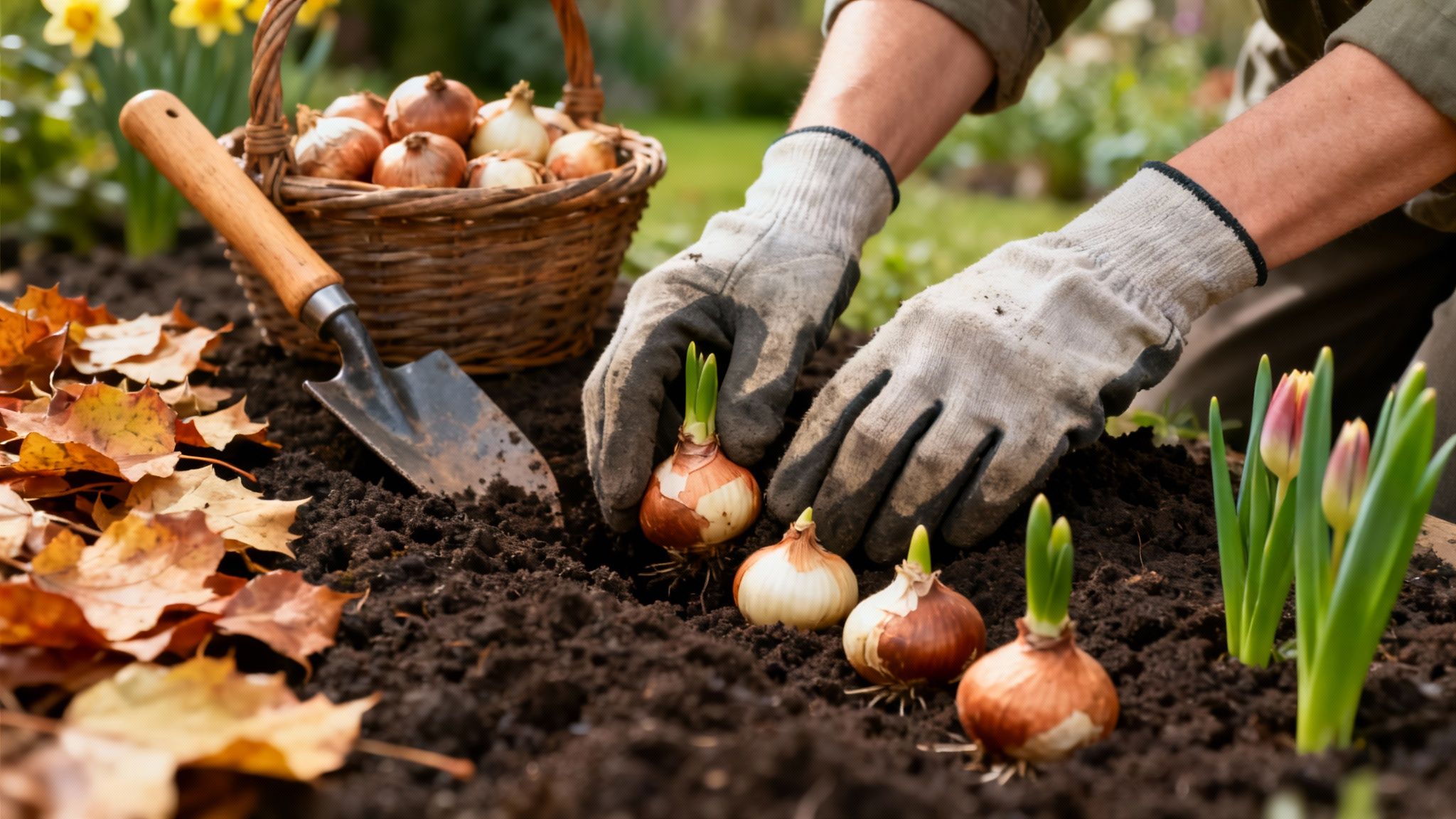Getting your plants through winter is about more than just throwing a fleece over them when you hear a frost is coming. It’s a game of preparation. Getting your hands dirty with some soil prep, laying down the right kind of mulch, and picking the best physical covers are what make the real difference. A solid winter strategy doesn't just help your garden survive—it sets it up to come back stronger than ever in the spring.
Why Bother Protecting Plants in a UK Winter?
Let's face it, UK winters can be a real piece of work. They're notoriously fickle, swinging from soggy and mild to a sudden, bone-chilling frost that can catch even the most experienced gardeners off-guard. It's this wild unpredictability that makes a winter protection plan absolutely essential, not just a nice-to-have.
One minute, your gorgeous tender perennials—think dahlias or those vibrant salvias—are looking happy and healthy. The next, a single surprise freeze turns them into a pile of mush. It’s heartbreaking. You're not just losing a few plants; you're losing all the time, effort, and care you’ve poured into your garden all year. The real enemies here aren't just the cold temperatures, but a nasty combination of challenges specific to our climate.
Understanding the Main Threats
In a typical British winter, your plants are up against more than just a dip on the thermometer. You’ve got to be ready for a few specific troublemakers:
- Sudden Cold Snaps: When the temperature plummets without warning, plants that haven't had a chance to harden off can go into shock.
- Biting Winds: Those icy gales are a real menace. They can easily dry out evergreen foliage, causing windburn that leaves plants looking scorched and weak.
- The Relentless Damp: Our winters are often wet. Really wet. This leads to waterlogged soil, which is a one-way ticket to root rot—a silent killer for so many plants.
- Frost Pockets: Every garden has its own little microclimates. Those low-lying spots can get significantly colder than the rest of your garden, creating deadly pockets of frost.
We saw this play out during the winter of 2023-2024, when sudden, deep freezes caused havoc in gardens across the country. The Royal Horticultural Society (RHS) reported that temperatures in some southern frost pockets dropped to a staggering -12°C. After a fairly mild autumn, this severe cold was a death sentence for many plants that simply hadn't had time to acclimatise. You can read more about the fallout in the RHS winter plant survey.
Think of your winter prep as an insurance policy for your garden. It’s your best defence against the UK's erratic weather, ensuring the beauty you worked so hard for in summer returns next year.
Before you start, it's worth knowing which of your plants are most at risk. Some are naturally tough as old boots, while others need a bit more coddling.
Winter Hardiness Quick Guide By Plant Type
This table gives you a quick rundown of common garden plants and how much attention they'll likely need to get through a UK winter unscathed.
Knowing who needs what is half the battle. This way, you can focus your efforts where they're needed most.
Ultimately, protecting your plants is all about thinking ahead. It means getting to know your garden’s unique quirks and timing your jobs just right. For a full breakdown of what to do and when, our gardening calendar offers a super helpful month-by-month guide. By preparing for the worst, you give your garden the resilience it needs to not just make it through the winter, but to burst back into glorious life when spring finally arrives.
Building Your Garden's First Line of Defence
Before you even start thinking about horticultural fleece or fancy covers, the real work of protecting plants in winter begins in the soil. A garden that can tough out the cold is built on a solid foundation, and that means getting your beds and soil ready for the freeze. This is more than just scattering some mulch; it’s about creating an environment where roots can survive the one-two punch of cold and wet that defines a British winter.

It's easy to focus on protecting plants from frost from above, but what’s happening underground is often far more important. Saturated, frozen soil is a killer. It can suffocate and destroy roots much more efficiently than a few chilly nights. Get your soil prep right, and you give your plants a fighting chance.
Tackling Heavy Soil and Poor Drainage
Here in the UK, heavy clay soil is a familiar foe for many of us. While it's fantastically fertile in the summer, it can quickly turn into a waterlogged death trap come winter. When water can't drain away, it pools around the plant's root ball. As temperatures drop, that water freezes into a solid block of ice, damaging the delicate root structure and inviting rot.
Root rot truly is the silent assassin in our damp winter gardens. Improving your drainage isn't just a good idea; for anyone with clay-heavy soil, it's essential.
- Dig in organic matter: Before the cold really sets in, work generous amounts of well-rotted compost or leaf mould into your beds. This opens up the dense clay, creating tiny air pockets that let excess water drain away.
- Add horticultural grit: For those really stubborn, claggy spots, mixing in some coarse grit or sharp sand can be a complete game-changer. It physically separates the clay particles, creating permanent channels for water to escape.
Think of this as an ongoing project. Each autumn that you add more organic material, you're gradually improving your soil's structure for the long term, making your garden tougher with every passing year.
The Art of Mulching for Winter Insulation
Once your soil is in better shape, it's time to add a protective layer of mulch. This is basically a cosy duvet for your plant's roots, insulating them from the worst of the temperature swings. But not all mulches are created equal, and using the right one for the right job is crucial.
I’ve seen it so many times: a thick, wet mulch that ends up suffocating the soil. The aim is a light, airy blanket that traps warmth and sheds moisture, not a soggy cap that encourages rot.
Let's break down the best choices for winter protection.
Comparing Winter Mulch Materials
A quick but vital tip: when you're mulching around plants like roses or fuchsias, always leave a small gap—a little "collar"—right around the base of the stem. Piling mulch directly against the plant's crown traps moisture and can cause it to decay, which completely defeats the purpose.
By giving your garden this foundational defence, you’re not just crossing your fingers and hoping for the best. You're building a stronger, healthier garden that will be raring to go next spring.
Choosing the Right Winter Protection Cover
So, you’ve sorted the soil and laid down a good, thick mulch. The next step is thinking about that final layer of defence against the winter chill. When a hard frost is forecast, a physical cover is often the only thing standing between your precious plants and some serious damage. But there are a lot of options out there, from simple fleece to sturdy cold frames, so picking the right one is key to protecting plants in winter.

The goal isn't just to block out the cold. It's about creating a stable little microclimate that shields your plants from frost, wind, and excessive rain, but without suffocating them. A well-chosen cover can truly be the difference between a thriving survivor and a mushy casualty come spring.
Comparing Common Winter Covers
Not all covers are created equal, and the best choice really depends on the plant you’re protecting and the specific weather you’re up against. Are we talking about a light frost or a week of icy gales? Let's break down the most common options and what they’re best for.
Horticultural Fleece: This is the gardener's go-to for a reason. It's a lightweight, breathable fabric that gives you a few extra degrees of frost protection without trapping too much moisture. It’s perfect for draping over beds of half-hardy perennials, like salvias or penstemons, when a cold snap is on the way. You can just secure it with pegs or weigh the edges down with a few stones. Easy.
Hessian (Burlap): A brilliant choice for protecting shrubs and the trunks of more established specimen trees, like tree ferns or olives, from harsh wind and deep cold. Hessian is much tougher than fleece, offering better insulation. For something really precious like a tree fern, I’ll often pack the crown with straw first and then wrap the entire thing securely in a couple of layers of hessian, tied on with garden twine.
Cloches: These are just individual protective covers, traditionally made from glass but more often from plastic these days. A cloche is basically a mini-greenhouse, perfect for shielding a single small plant or giving early sowings a bit of a head start. You can even fashion your own from old plastic bottles. Just be mindful they can get surprisingly hot on a sunny winter day, so you need to let some air in.
Cold Frames: Think of a cold frame as a more permanent, heavy-duty solution. It’s essentially a box with a transparent, sloping lid, and it’s fantastic for overwintering alpine plants that absolutely hate sitting in wet soil. They’re also great for hardening off young plants or protecting pots of less hardy herbs. It offers solid protection from wind, rain, and frost.
I learned this the hard way: always remember to unwrap or vent your plants on mild, sunny days. Leaving the covers on can trap moisture and heat, which not only encourages fungal diseases but can also trick your plants into breaking dormancy too early. That just makes them vulnerable to the very next frost.
Securing Covers Against Winter Gales
Putting a cover on is one thing; making sure it stays put during a howling winter gale is another challenge entirely. A loose fleece flapping about in the wind can do more harm to a plant than the cold itself. Anchoring it properly isn't optional.
- For Fleece and Netting: Use specially designed ground pegs and push them firmly into the soil every metre or so. If you’re in a particularly windy spot, laying bricks or smooth stones along the entire edge is a much safer bet.
- For Wrapped Shrubs: When you’re using hessian, wrap it snugly, but not so tightly that you risk snapping branches. Secure it with plenty of garden twine, wrapping it spirally up the plant, almost like a bandage.
- For Taller Structures: If you’re building a temporary frame around a plant to hold a cover, make sure the stakes are driven deep into the ground. You need them to be stable. This is especially important for windbreaks designed to protect larger evergreen shrubs.
By choosing the right material and securing it properly, you create a safe little haven that gives your plants the best possible chance of sailing through the winter unscathed. It’s this kind of careful, considered effort that really pays off when you see everything burst back into life in the spring.
Overwintering Container and Tender Plants
Plants living in pots are a special case. While their counterparts in the ground benefit from the earth's natural insulation, container plants face the cold from every direction. Their roots are exposed to freezing air right through the sides of the pot, making them uniquely vulnerable to damage. Protecting plants in winter, especially those in containers, really needs a dedicated strategy.

The first job is a simple audit of what you’re growing. Not all potted plants need to be treated the same, so the goal is to decide which ones can be helped to tough it out outdoors and which absolutely must come inside for the season.
Deciding Who Stays and Who Goes
The choice nearly always comes down to plant hardiness. Some plants, like many hardy evergreen shrubs or heathers, are perfectly capable of surviving a UK winter in a pot, provided they’re given a little help. On the other hand, tender specimens simply have no chance.
- Bring Indoors: Tender plants like pelargoniums (what many of us call geraniums), fuchsias that aren't hardy, citrus trees, and succulents must be brought inside. They just can't tolerate frost.
- Leave Outdoors (with protection): Hardy perennials, small shrubs like box or yew, and alpines can generally stay outside. However, their roots will still need protecting from the worst of the freeze-thaw cycle.
Once you have your two groups, you can put a clear plan in place for each. For those coming indoors, the goal is dormancy, not active growth. For those staying out, it's all about insulation and drainage.
Strategies for Outdoor Pots
For the hardy plants that will remain in the garden, you can significantly boost their odds with a few simple techniques. The key is to shield their vulnerable root systems from the biting cold and prevent the pots from becoming waterlogged.
A combination of these methods gives the best defence:
- Cluster Them Together: Grouping your pots in a sheltered spot—against a south-facing house wall or tucked in a corner protected from the wind—creates a shared microclimate. The plants and pots help to insulate one another, lessening the impact of freezing temperatures.
- Wrap the Pots: For an extra layer of insulation, wrap the pots (not the plants themselves) in bubble wrap or hessian, secured with garden twine. This simple jacket stops the soil from freezing solid and protects terracotta pots, which can crack if they freeze when wet.
- Lift Them Up: Never let your pots sit directly on the cold, wet ground. Raising them up on "pot feet" or even a few bricks is crucial. This lets excess water drain away freely, which is vital for preventing root rot and stopping the pot from freezing to the patio.
Think of it like this: leaving a pot on the ground is like standing in a cold puddle. Lifting it up is like putting on a pair of wellies. It keeps the feet dry and protected from the worst of the chill.
These simple, practical steps can make a world of difference for your container garden, helping your plants survive the winter and bounce back with vigour in the spring. If you're planning your potted displays for next year, you might find some inspiration in our guide to garden border plant ideas, which includes many varieties that perform beautifully in containers.
Caring for Plants Brought Indoors
Bringing plants inside isn't just about moving them from one spot to another. You need to create the right environment to see them through their dormant period. A common mistake is treating them like active houseplants, which often leads to problems.
The ideal location is cool but bright and, most importantly, frost-free. An unheated conservatory, a light-filled garage, or even a porch are all excellent choices. Avoid warm, centrally heated living rooms; the dry air and high temperatures can confuse the plant, encouraging weak, leggy growth when it should be resting.
Follow these tips for happy indoor overwintering:
- Reduce Watering Drastically: A dormant plant needs very little water. Check the compost every few weeks and only water sparingly when it feels dry to the touch. Overwatering is the number one killer of overwintering plants.
- Stop Feeding: The plant is resting, so it doesn't need any fertiliser until you see signs of new growth in the spring.
- Check for Pests: Before you bring them in, give your plants a good check-over for any pests like aphids or vine weevils. The warmer indoor conditions can cause pest populations to explode.
- Provide Airflow: Good air circulation is important to prevent fungal diseases like grey mould. Don’t overcrowd your plants and, if you can, open a window for a while on milder days.
By providing these specific conditions, you give your tender plants the restful winter break they need to recharge for a spectacular display next summer.
Essential Winter Watering and Plant Health Checks
Once you’ve carefully tucked your garden in for its winter slumber, it’s all too easy to shut the back door and forget about it until the first signs of spring. But honestly, this is where the real work of protecting plants in winter comes in. This maintenance phase, while less intense, is what separates a garden that merely survives from one that will bounce back with vigour.
Two of the most common pitfalls I see are with winter watering and health checks. They're often overlooked but absolutely critical.

It sounds a bit mad, doesn't it? Watering plants in a season known for being cold and damp. But ‘winter drought’ is a very real threat, a silent problem that can cause a surprising amount of damage, especially to evergreens and container plants.
The Myth of Winter Dormancy and Water
A common belief is that dormant plants don't need any water at all. While their needs are massively reduced, they certainly aren't zero. Evergreens, in particular, continue to lose moisture through their leaves or needles all winter, especially on those surprisingly bright or windy days. If the ground is frozen solid, their roots can't draw up any water to replace what’s lost.
This creates a state of physiological drought—the plant is essentially dying of thirst, even when it's surrounded by ice or sodden ground. I've seen it happen countless times with broadleaf evergreens like rhododendrons and camellias.
Think of yourself as a hydration monitor. The goal is to water correctly—only when needed and at the right time—to prevent the twin dangers of dehydration on one hand and root rot on the other.
So, how do you know when to water? Simple. Forget the guesswork and use your fingers. Push your finger about two inches into the soil, both in your pots and at the base of your garden plants. If it feels dry at that depth, it’s time for a drink. If it’s moist or frozen solid, leave it be.
Smart Winter Watering Practices
When your plants do need watering, how and when you do it makes all the difference. Get it wrong, and you can cause more harm than good.
- Water on a milder day. Pick a day when the air temperature is above freezing, ideally 4-5°C or higher. This gives the water a chance to actually soak into the soil before it freezes.
- Water in the morning. This allows the plant plenty of time to absorb what it needs before temperatures dip again overnight.
- Focus on the root zone. Apply water directly to the soil around the base of the plant. Try to avoid wetting the foliage, as damp leaves in winter are an open invitation for fungal diseases.
- Water deeply, but infrequently. A really good soak every few weeks during a dry, cold spell is far more effective than frequent, light sprinklings.
The impact of winter conditions isn't just a garden-scale issue; it affects UK agriculture on a huge scale. For instance, challenging winter weather recently contributed to a significant 7% decline in winter barley planting across the UK—the smallest area planted since 2020. It just goes to show how crucial managing winter moisture is for plant survival, whether in a farm field or a back garden. You can discover more insights about these crop survey results.
Performing Regular Health Checks
Underneath those cosy fleeces and cloches, things can get pretty humid and stagnant. Unfortunately, this creates the perfect breeding ground for pests and diseases. A quick peek every couple of weeks is a vital part of protecting your plants.
On a mild day, gently lift your covers and have a proper look. You’re on the hunt for early signs of trouble before they can really take hold.
What to Look For:
- Pests: Aphids and other little critters can thrive in those sheltered winter spots. Always check the undersides of leaves and any new growth.
- Fungal Diseases: Keep an eye out for grey mould (botrytis), which looks like a fuzzy grey growth on stems and leaves, especially where air can't circulate well.
- Rodent Damage: Mice and voles sometimes fancy a winter meal and will chew on the bark of shrubs and trees. Check the base of stems for any tell-tale gnawing.
- Rot: Gently feel the plant's crown (where the stem meets the roots). Any soft, mushy, or discoloured areas are classic signs of rot setting in.
If you spot a problem, act fast. Snip off any affected leaves or stems, wipe away small pest colonies with a damp cloth, and make sure the plant has enough airflow. This simple, proactive check-up ensures all your hard work isn't undone from within, giving your plants the absolute best chance of emerging healthy and raring to go in the spring.
Adapting Your Garden for Future Winters

Getting your plants through winter isn't just a yearly chore; it's about building a tougher, more resilient garden for the long haul. Let's face it, our climate is changing. With wetter winters and unpredictable frosts becoming the new normal, we need to think a little differently about how we garden.
It’s about moving away from last-minute panic and towards creating a garden that can naturally withstand whatever the British weather decides to throw at it. A huge part of this strategy starts with choosing the right plants in the first place. When you opt for species that are already suited to our climate—or even a touch hardier—you save yourself a lot of work down the line.
The need for this forward-thinking approach is becoming clearer all the time, and not just in our back gardens. The recent wet and cold winter has hit UK agriculture hard, with experts forecasting a 17.5% drop in key crop production for 2024 compared to last year. This really brings home the wider need for smarter, more adaptive strategies. You can read the full analysis of the wet winter's impact on UK production to see the bigger picture.
Get to Know Your Garden’s Microclimates
Every garden has its own personality, with unique weather patterns known as microclimates. These are the little pockets and zones where conditions can be surprisingly different from the garden as a whole. Learning to spot them and use them to your advantage is one of the best skills you can develop.
Next time you're out there, really look around. Is there a sheltered corner by a south-facing wall that always feels a bit warmer? That’s gold dust—a perfect spot for a plant that’s a little on the tender side. On the flip side, do you have a low-lying, exposed patch that seems to get frosted over first? That's a classic frost pocket, and no place for anything delicate.
Your garden is a living system. By observing its unique personality—the warm spots, the windy corridors, the damp corners—you can work with it, not against it. This deepens your connection and makes your efforts far more rewarding.
Double Down on the Winter Essentials
Building a truly resilient garden also means making those core winter care principles second nature. It's about getting the fundamentals right, year after year, until they're just part of your routine.
- Smart Plant Choices: Focus on varieties known for their toughness. If you want some inspiration for creating displays that are both beautiful and hardy, you might like our guide on low-maintenance garden ideas.
- Better Soil, Better Plants: Don't skip the autumn soil prep. Improving its drainage and structure is a long-term investment that pays massive dividends for plant health.
- Stay Vigilant: Never just cover your plants and forget about them. Regular checks for moisture, pests, and signs of disease are absolutely essential, even in the depths of winter.
Ultimately, mastering winter plant protection is an incredibly rewarding skill. It shifts you from being a passive gardener to an active guardian of your green space, ensuring it not only survives the cold but is ready to burst into life and colour when spring finally arrives.
Frequently Asked Questions
When it comes to protecting plants in winter, a few questions always seem to pop up. Let's tackle some of the most common ones gardeners across the UK ask when the cold weather starts to bite.
When Is the Best Time to Start Protecting My Plants for Winter in the UK?
Honestly, there's no single magic date. The sweet spot is after the first light frost has nipped the air, but before the first really hard freeze sets in. This gives your plants a chance to start toughening up on their own.
For most of us here in the UK, this usually means late October or early November. The best advice? Keep a close eye on the long-range weather forecast. As soon as you see a proper cold snap on the horizon, that's your cue to get everything tucked in for winter.
Can I Leave Horticultural Fleece on My Plants All Winter?
It's tempting, isn't it? But horticultural fleece isn't really a "set it and forget it" deal. Think of it more like a cosy duvet for the coldest nights, not a permanent winter coat.
Leaving fleece on all the time can trap moisture right up against the leaves and crown. This creates the perfect damp, airless conditions for rot and other fungal nasties to take hold.
It’s much better to whip the fleece off during milder, sunny winter days. This lets your plants breathe and stops them from getting soft, which would only make them more vulnerable when the next big freeze arrives.
My Garden Soil Is Very Wet and Heavy. Will Mulch Make It Worse?
A brilliant question, and a real worry if you're gardening on heavy clay. You're right to be cautious. Piling on a thick, dense mulch like fine compost can turn into a soggy, compacted mess, trapping way too much water around the roots.
The best approach here is to first focus on improving your soil's drainage over time by digging in some grit and well-rotted organic matter. When you do mulch, go for something coarse and airy. Big chunky bark chippings or even straw are great options. They'll insulate the roots beautifully without suffocating the soil, allowing it to breathe and shed that excess winter rain.




